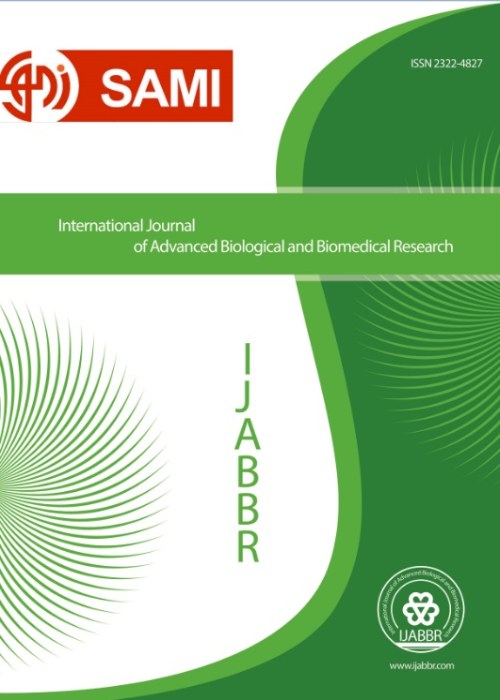Lipophilic Vitamins (D and E) and Flavonoids (Quercetin and Naringin) Attenuate the Effects of Dichlorvos Toxicity on Catalase Activity
Author(s):
Mubaraq Damilare Yussuf * , Alowoeshin Oluwaseun Samuel , Umoren Dayo Otoh , Irimoren Osaruese Emmanuella , Ike Chigozie Okechukwu , Sulaimon Olajuwon Abdul , Okafor Chukwudi Stanley , Adenike Okunade Ambrose , Olamide Tayo Akintola , Hannah Aderinsola Osibodu , Omeiza Momoh , Dayo Abdulwaheed Soleye
Article Type:
Research/Original Article (دارای رتبه معتبر)
Abstract:
[Dichlorvos (2,2-dichlorovinyl dimethyl phosphate) is an organophosphate pesticide and insecticide used all over the world. Catalase is an enzyme that is responsible for degrading hydrogen peroxides present in organs or blood cells and tissue to prevent oxidative damage to these respected organs. The flavonoids (naringin and quercetin) and vitamin D and E have been found to reduce oxidative stress in the body. The study was carried out to detect the effect of specific lipophilic vitamins, naringin, and quercetin on catalase activity in the presence of a dichlorvos induced system. 112 male rats were divided into 14 groups of 8 rats each grouped as positive and negative control groups, dichlorvos only induced groups (2 groups), vitamins only induced groups (vitamin D and vitamin E), flavonoids only induced groups (quercetin and naringin), dichlorvos + vitamins administered groups (2 group each containing a different vitamin administration), and dichlorvos + flavonoids administered groups, baseline group and DMSO4 group. They were administered the dichlorvos for two weeks, and subsequent administration of vitamin D and E with naringin and quercetin respectively two weeks after. The animals were weighed every three days and were sacrificed immediately after administration, plasma and RBC along with the organs (liver and brain) were used to assess the effects of the vitamins and phytochemicals antioxidant capacity on catalase activity of the animals. Results showed that specific vitamin D, naringin, and quercetin were most important in their antioxidant capacity and helped improved catalase activity of initially treated dichlorvos group in some organs and compartments with the brain and red blood cells mostly benefitting from it with dichlorvos + vitamin D group, and vitamin D group having an SEM of 0.141±0.0044 and 0.150±0.00069, respectively, in the red blood cells. Meanwhile, the phytochemicals (naringin and quercetin) were more prominent in attenuating catalase activity in the brain with dichlorvos + naringin group and naringin group recording an SEM of 2.216±0.067 and 2.302±0.076, respectively, and dichlorvos + quercetin group and quercetin group recorded an SEM of 0.670±0.009 and 1.276±0.060, respectively. As a result, the fat-soluble vitamins, and phytochemicals reduced dichlorvos toxicity, but could not offer complete and absolute protection against the hydrogen peroxides and oxidative stress produced.
Keywords:
Language:
English
Published:
International Journal of Advanced Biological and Biomedical Research, Volume:12 Issue: 1, Winter 2024
Pages:
67 to 91
magiran.com/p2679031
دانلود و مطالعه متن این مقاله با یکی از روشهای زیر امکان پذیر است:
اشتراک شخصی
با عضویت و پرداخت آنلاین حق اشتراک یکساله به مبلغ 1,390,000ريال میتوانید 70 عنوان مطلب دانلود کنید!
اشتراک سازمانی
به کتابخانه دانشگاه یا محل کار خود پیشنهاد کنید تا اشتراک سازمانی این پایگاه را برای دسترسی نامحدود همه کاربران به متن مطالب تهیه نمایند!
توجه!
- حق عضویت دریافتی صرف حمایت از نشریات عضو و نگهداری، تکمیل و توسعه مگیران میشود.
- پرداخت حق اشتراک و دانلود مقالات اجازه بازنشر آن در سایر رسانههای چاپی و دیجیتال را به کاربر نمیدهد.
In order to view content subscription is required
Personal subscription
Subscribe magiran.com for 70 € euros via PayPal and download 70 articles during a year.
Organization subscription
Please contact us to subscribe your university or library for unlimited access!


